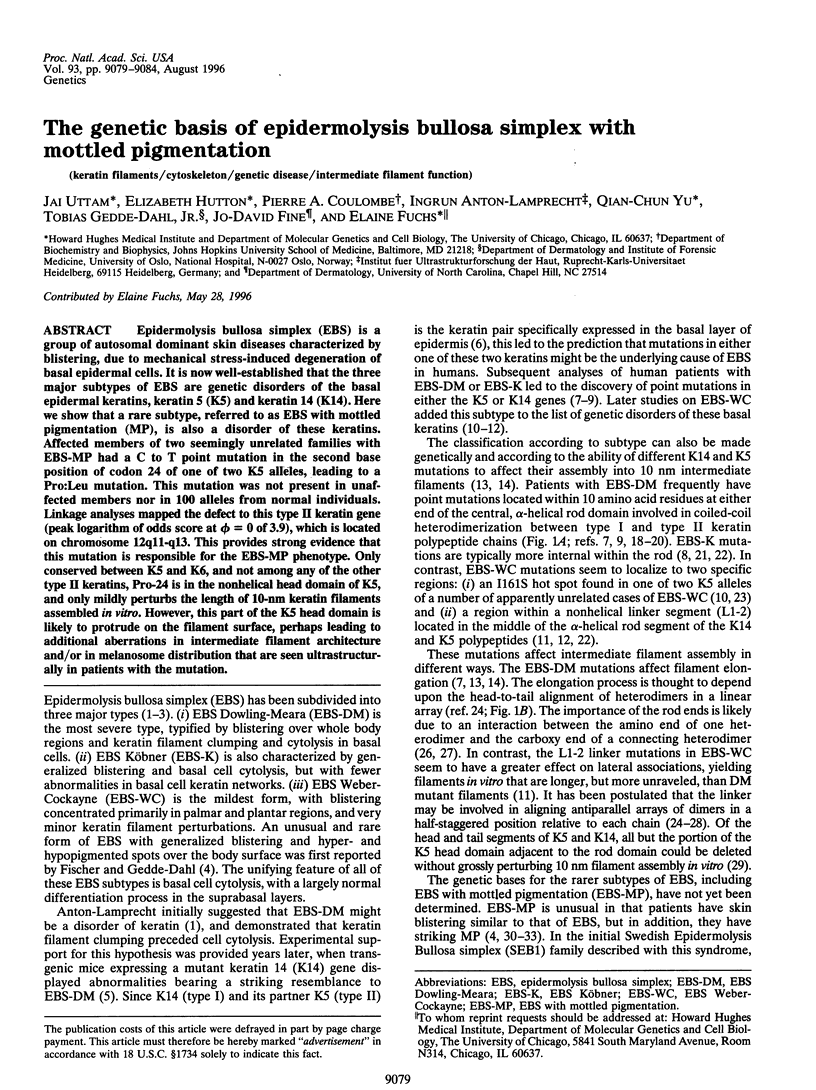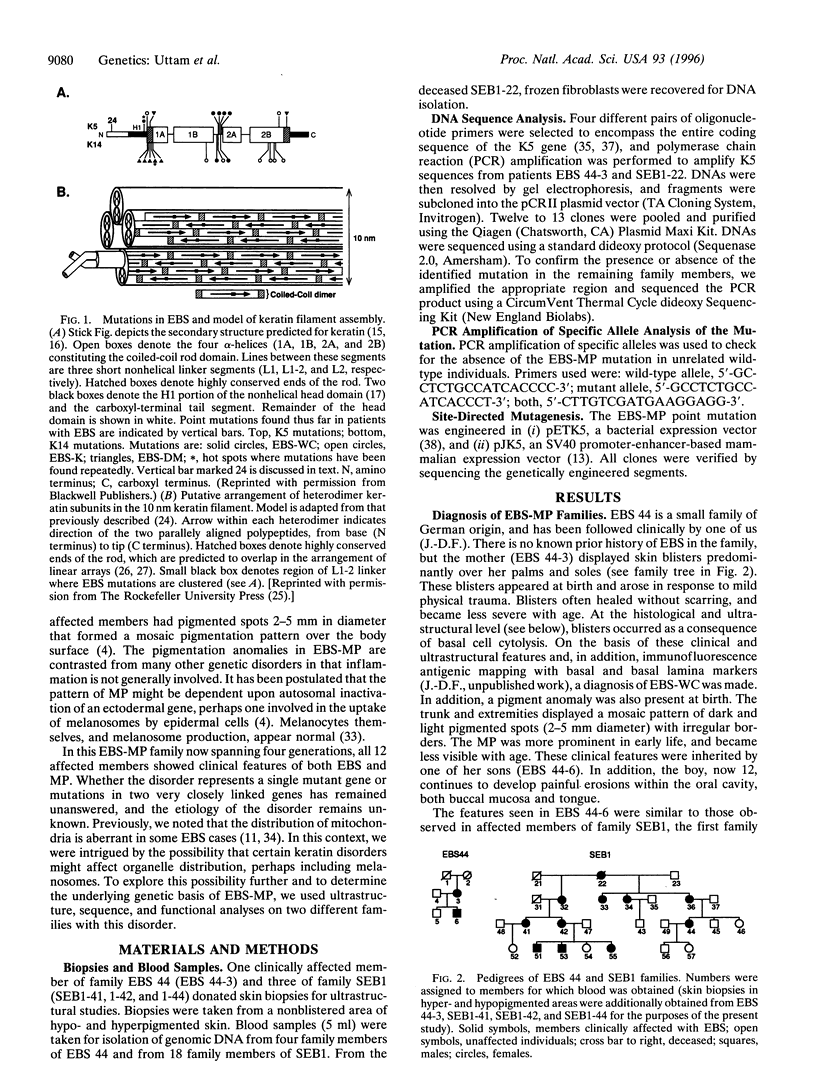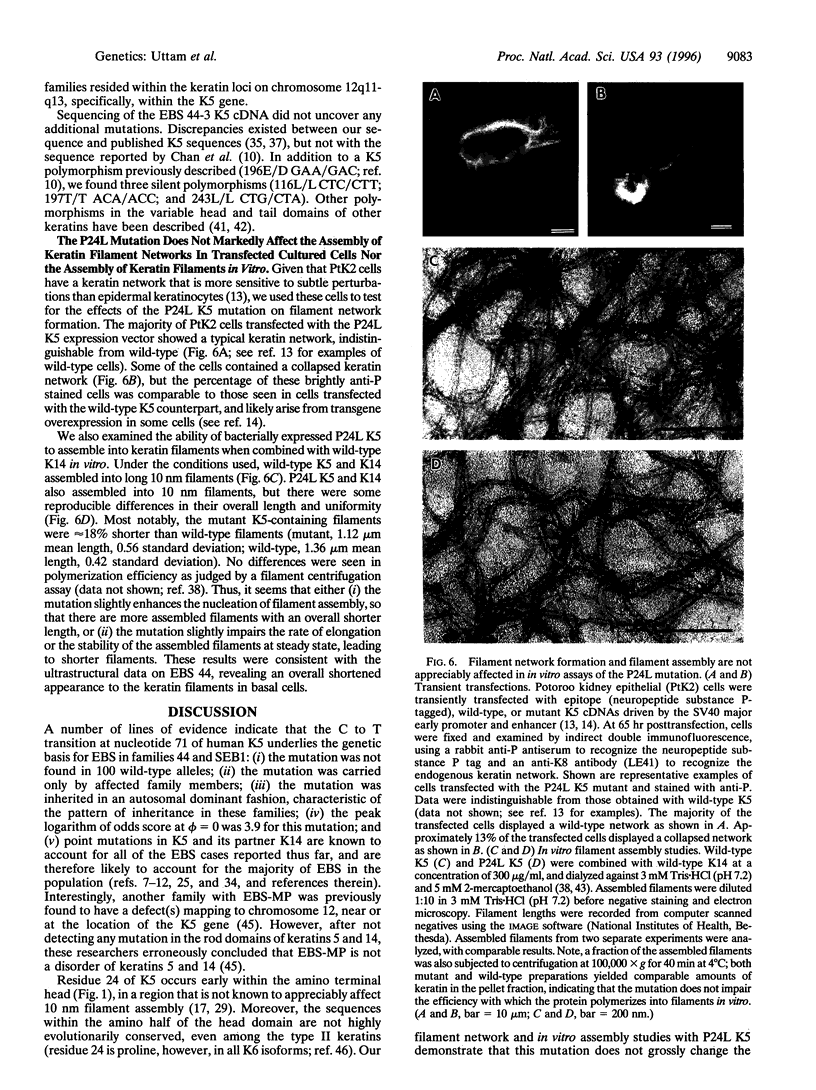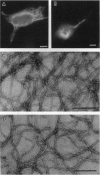Abstract
Epidermolysis bullosa simplex (EBS) is a group of autosomal dominant skin diseases characterized by blistering, due to mechanical stress-induced degeneration of basal epidermal cells. It is now well-established that the three major subtypes of EBS are genetic disorders of the basal epidermal keratins, keratin 5 (K5) and keratin 14 (K14). Here we show that a rare subtype, referred to as EBS with mottled pigmentation (MP), is also a disorder of these keratins. Affected members of two seemingly unrelated families with EBS-MP had a C to T point mutation in the second base position of codon 24 of one of two K5 alleles, leading to a Pro: Leu mutation. This mutation was not present in unaffected members nor in 100 alleles from normal individuals. Linkage analyses mapped the defect to this type II keratin gene (peak logarithm of odds score at phi = 0 of 3.9), which is located on chromosome 12q11-q13. This provides strong evidence that this mutation is responsible for the EBS-MP phenotype. Only conserved between K5 and K6, and not among any of the other type II keratins, Pro-24 is in the nonhelical head domain of K5, and only mildly perturbs the length of 10-nm keratin filaments assembled in vitro. However, this part of the K5 head domain is likely to protrude on the filament surface, perhaps leading to additional aberrations in intermediate filament architecture and/or in melanosome distribution that are seen ultrastructurally in patients with the mutation.
Full text
PDF





Images in this article
Selected References
These references are in PubMed. This may not be the complete list of references from this article.
- Anton-Lamprecht I. Genetically induced abnormalities of epidermal differentiation and ultrastructure in ichthyoses and epidermolyses: pathogenesis, heterogeneity, fetal manifestation, and prenatal diagnosis. J Invest Dermatol. 1983 Jul;81(1 Suppl):149s–156s. doi: 10.1111/1523-1747.ep12540961. [DOI] [PubMed] [Google Scholar]
- Anton-Lamprecht I. Ultrastructural identification of basic abnormalities as clues to genetic disorders of the epidermis. J Invest Dermatol. 1994 Nov;103(5 Suppl):6S–12S. doi: 10.1111/1523-1747.ep12398887. [DOI] [PubMed] [Google Scholar]
- Bonifas J. M., Rothman A. L., Epstein E. H., Jr Epidermolysis bullosa simplex: evidence in two families for keratin gene abnormalities. Science. 1991 Nov 22;254(5035):1202–1205. doi: 10.1126/science.1720261. [DOI] [PubMed] [Google Scholar]
- Bruckner-Tuderman L., Vogel A., Rüegger S., Odermatt B., Tönz O., Schnyder U. W. Epidermolysis bullosa simplex with mottled pigmentation. J Am Acad Dermatol. 1989 Aug;21(2 Pt 2):425–432. doi: 10.1016/s0190-9622(89)80052-0. [DOI] [PubMed] [Google Scholar]
- Chan Y. M., Cheng J., Gedde-Dahl T., Jr, Niemi K. M., Fuchs E. Genetic analysis of a severe case of Dowling-Meara epidermolysis bullosa simplex. J Invest Dermatol. 1996 Feb;106(2):327–334. doi: 10.1111/1523-1747.ep12342985. [DOI] [PubMed] [Google Scholar]
- Chan Y. M., Yu Q. C., Fine J. D., Fuchs E. The genetic basis of Weber-Cockayne epidermolysis bullosa simplex. Proc Natl Acad Sci U S A. 1993 Aug 1;90(15):7414–7418. doi: 10.1073/pnas.90.15.7414. [DOI] [PMC free article] [PubMed] [Google Scholar]
- Chan Y. M., Yu Q. C., LeBlanc-Straceski J., Christiano A., Pulkkinen L., Kucherlapati R. S., Uitto J., Fuchs E. Mutations in the non-helical linker segment L1-2 of keratin 5 in patients with Weber-Cockayne epidermolysis bullosa simplex. J Cell Sci. 1994 Apr;107(Pt 4):765–774. doi: 10.1242/jcs.107.4.765. [DOI] [PubMed] [Google Scholar]
- Chan Y., Anton-Lamprecht I., Yu Q. C., Jäckel A., Zabel B., Ernst J. P., Fuchs E. A human keratin 14 "knockout": the absence of K14 leads to severe epidermolysis bullosa simplex and a function for an intermediate filament protein. Genes Dev. 1994 Nov 1;8(21):2574–2587. doi: 10.1101/gad.8.21.2574. [DOI] [PubMed] [Google Scholar]
- Chen H., Bonifas J. M., Matsumura K., Ikeda S., Leyden W. A., Epstein E. H., Jr Keratin 14 gene mutations in patients with epidermolysis bullosa simplex. J Invest Dermatol. 1995 Oct;105(4):629–632. doi: 10.1111/1523-1747.ep12323846. [DOI] [PubMed] [Google Scholar]
- Coleman R., Harper J. I., Lake B. D. Epidermolysis bullosa simplex with mottled pigmentation. Br J Dermatol. 1993 Jun;128(6):679–685. doi: 10.1111/j.1365-2133.1993.tb00265.x. [DOI] [PubMed] [Google Scholar]
- Combemale P., Kanitakis J. Epidermolysis bullosa simplex with mottled pigmentation. Case report and review of the literature. Dermatology. 1994;189(2):173–178. doi: 10.1159/000246826. [DOI] [PubMed] [Google Scholar]
- Coulombe P. A., Chan Y. M., Albers K., Fuchs E. Deletions in epidermal keratins leading to alterations in filament organization in vivo and in intermediate filament assembly in vitro. J Cell Biol. 1990 Dec;111(6 Pt 2):3049–3064. doi: 10.1083/jcb.111.6.3049. [DOI] [PMC free article] [PubMed] [Google Scholar]
- Coulombe P. A., Fuchs E. Elucidating the early stages of keratin filament assembly. J Cell Biol. 1990 Jul;111(1):153–169. doi: 10.1083/jcb.111.1.153. [DOI] [PMC free article] [PubMed] [Google Scholar]
- Coulombe P. A., Hutton M. E., Letai A., Hebert A., Paller A. S., Fuchs E. Point mutations in human keratin 14 genes of epidermolysis bullosa simplex patients: genetic and functional analyses. Cell. 1991 Sep 20;66(6):1301–1311. doi: 10.1016/0092-8674(91)90051-y. [DOI] [PubMed] [Google Scholar]
- Dong W., Ryynänen M., Uitto J. Identification of a leucine-to-proline mutation in the keratin 5 gene in a family with the generalized Köbner type of epidermolysis bullosa simplex. Hum Mutat. 1993;2(2):94–102. doi: 10.1002/humu.1380020206. [DOI] [PubMed] [Google Scholar]
- Eckert R. L., Rorke E. A. The sequence of the human epidermal 58-kD (#5) type II keratin reveals an absence of 5' upstream sequence conservation between coexpressed epidermal keratins. DNA. 1988 Jun;7(5):337–345. doi: 10.1089/dna.1.1988.7.337. [DOI] [PubMed] [Google Scholar]
- Ehrlich P., Sybert V. P., Spencer A., Stephens K. A common keratin 5 gene mutation in epidermolysis bullosa simplex--Weber-Cockayne. J Invest Dermatol. 1995 May;104(5):877–879. doi: 10.1111/1523-1747.ep12607050. [DOI] [PubMed] [Google Scholar]
- Fine J. D., Bauer E. A., Briggaman R. A., Carter D. M., Eady R. A., Esterly N. B., Holbrook K. A., Hurwitz S., Johnson L., Lin A. Revised clinical and laboratory criteria for subtypes of inherited epidermolysis bullosa. A consensus report by the Subcommittee on Diagnosis and Classification of the National Epidermolysis Bullosa Registry. J Am Acad Dermatol. 1991 Jan;24(1):119–135. doi: 10.1016/0190-9622(91)70021-s. [DOI] [PubMed] [Google Scholar]
- Fischer T., Gedde-Dahl T., Jr Epidermolysis bullosa simplex and mottled pigmentation: a new dominant syndrome. I. Clinical and histological features. Clin Genet. 1979 Mar;15(3):228–238. doi: 10.1111/j.1399-0004.1979.tb00972.x. [DOI] [PubMed] [Google Scholar]
- Fuchs E., Coulombe P. A. Of mice and men: genetic skin diseases of keratin. Cell. 1992 Jun 12;69(6):899–902. doi: 10.1016/0092-8674(92)90607-e. [DOI] [PubMed] [Google Scholar]
- Fuchs E., Esteves R. A., Coulombe P. A. Transgenic mice expressing a mutant keratin 10 gene reveal the likely genetic basis for epidermolytic hyperkeratosis. Proc Natl Acad Sci U S A. 1992 Aug 1;89(15):6906–6910. doi: 10.1073/pnas.89.15.6906. [DOI] [PMC free article] [PubMed] [Google Scholar]
- Fuchs E., Green H. Changes in keratin gene expression during terminal differentiation of the keratinocyte. Cell. 1980 Apr;19(4):1033–1042. doi: 10.1016/0092-8674(80)90094-x. [DOI] [PubMed] [Google Scholar]
- Fuchs E. Intermediate filaments and disease: mutations that cripple cell strength. J Cell Biol. 1994 May;125(3):511–516. doi: 10.1083/jcb.125.3.511. [DOI] [PMC free article] [PubMed] [Google Scholar]
- Hanukoglu I., Fuchs E. The cDNA sequence of a Type II cytoskeletal keratin reveals constant and variable structural domains among keratins. Cell. 1983 Jul;33(3):915–924. doi: 10.1016/0092-8674(83)90034-x. [DOI] [PubMed] [Google Scholar]
- Hanukoglu I., Fuchs E. The cDNA sequence of a human epidermal keratin: divergence of sequence but conservation of structure among intermediate filament proteins. Cell. 1982 Nov;31(1):243–252. doi: 10.1016/0092-8674(82)90424-x. [DOI] [PubMed] [Google Scholar]
- Hatzfeld M., Weber K. A synthetic peptide representing the consensus sequence motif at the carboxy-terminal end of the rod domain inhibits intermediate filament assembly and disassembles preformed filaments. J Cell Biol. 1992 Jan;116(1):157–166. doi: 10.1083/jcb.116.1.157. [DOI] [PMC free article] [PubMed] [Google Scholar]
- Heins S., Wong P. C., Müller S., Goldie K., Cleveland D. W., Aebi U. The rod domain of NF-L determines neurofilament architecture, whereas the end domains specify filament assembly and network formation. J Cell Biol. 1993 Dec;123(6 Pt 1):1517–1533. doi: 10.1083/jcb.123.6.1517. [DOI] [PMC free article] [PubMed] [Google Scholar]
- Humphries M. M., Sheils D. M., Jordan S. A., Farrar G. J., Kumar-Singh R., Humphries P. Alu polymorphism in the human type I Keratin (KRT14) gene. Hum Mol Genet. 1992 Sep;1(6):453–453. doi: 10.1093/hmg/1.6.453. [DOI] [PubMed] [Google Scholar]
- Korge B. P., Gan S. Q., McBride O. W., Mischke D., Steinert P. M. Extensive size polymorphism of the human keratin 10 chain resides in the C-terminal V2 subdomain due to variable numbers and sizes of glycine loops. Proc Natl Acad Sci U S A. 1992 Feb 1;89(3):910–914. doi: 10.1073/pnas.89.3.910. [DOI] [PMC free article] [PubMed] [Google Scholar]
- Kouklis P. D., Hutton E., Fuchs E. Making a connection: direct binding between keratin intermediate filaments and desmosomal proteins. J Cell Biol. 1994 Nov;127(4):1049–1060. doi: 10.1083/jcb.127.4.1049. [DOI] [PMC free article] [PubMed] [Google Scholar]
- Lane E. B., Rugg E. L., Navsaria H., Leigh I. M., Heagerty A. H., Ishida-Yamamoto A., Eady R. A. A mutation in the conserved helix termination peptide of keratin 5 in hereditary skin blistering. Nature. 1992 Mar 19;356(6366):244–246. doi: 10.1038/356244a0. [DOI] [PubMed] [Google Scholar]
- Lathrop G. M., Lalouel J. M., Julier C., Ott J. Multilocus linkage analysis in humans: detection of linkage and estimation of recombination. Am J Hum Genet. 1985 May;37(3):482–498. [PMC free article] [PubMed] [Google Scholar]
- Lersch R., Stellmach V., Stocks C., Giudice G., Fuchs E. Isolation, sequence, and expression of a human keratin K5 gene: transcriptional regulation of keratins and insights into pairwise control. Mol Cell Biol. 1989 Sep;9(9):3685–3697. doi: 10.1128/mcb.9.9.3685. [DOI] [PMC free article] [PubMed] [Google Scholar]
- Letai A., Coulombe P. A., Fuchs E. Do the ends justify the mean? Proline mutations at the ends of the keratin coiled-coil rod segment are more disruptive than internal mutations. J Cell Biol. 1992 Mar;116(5):1181–1195. doi: 10.1083/jcb.116.5.1181. [DOI] [PMC free article] [PubMed] [Google Scholar]
- Letai A., Coulombe P. A., McCormick M. B., Yu Q. C., Hutton E., Fuchs E. Disease severity correlates with position of keratin point mutations in patients with epidermolysis bullosa simplex. Proc Natl Acad Sci U S A. 1993 Apr 15;90(8):3197–3201. doi: 10.1073/pnas.90.8.3197. [DOI] [PMC free article] [PubMed] [Google Scholar]
- Marchuk D., McCrohon S., Fuchs E. Complete sequence of a gene encoding a human type I keratin: sequences homologous to enhancer elements in the regulatory region of the gene. Proc Natl Acad Sci U S A. 1985 Mar;82(6):1609–1613. doi: 10.1073/pnas.82.6.1609. [DOI] [PMC free article] [PubMed] [Google Scholar]
- Mischke D., Wild G. Polymorphic keratins in human epidermis. J Invest Dermatol. 1987 Feb;88(2):191–197. doi: 10.1111/1523-1747.ep12525329. [DOI] [PubMed] [Google Scholar]
- Rugg E. L., McLean W. H., Lane E. B., Pitera R., McMillan J. R., Dopping-Hepenstal P. J., Navsaria H. A., Leigh I. M., Eady R. A. A functional "knockout" of human keratin 14. Genes Dev. 1994 Nov 1;8(21):2563–2573. doi: 10.1101/gad.8.21.2563. [DOI] [PubMed] [Google Scholar]
- Rugg E. L., Morley S. M., Smith F. J., Boxer M., Tidman M. J., Navsaria H., Leigh I. M., Lane E. B. Missing links: Weber-Cockayne keratin mutations implicate the L12 linker domain in effective cytoskeleton function. Nat Genet. 1993 Nov;5(3):294–300. doi: 10.1038/ng1193-294. [DOI] [PubMed] [Google Scholar]
- Steinert P. M., Marekov L. N., Fraser R. D., Parry D. A. Keratin intermediate filament structure. Crosslinking studies yield quantitative information on molecular dimensions and mechanism of assembly. J Mol Biol. 1993 Mar 20;230(2):436–452. doi: 10.1006/jmbi.1993.1161. [DOI] [PubMed] [Google Scholar]
- Steinert P. M., Parry D. A. The conserved H1 domain of the type II keratin 1 chain plays an essential role in the alignment of nearest neighbor molecules in mouse and human keratin 1/keratin 10 intermediate filaments at the two- to four-molecule level of structure. J Biol Chem. 1993 Feb 5;268(4):2878–2887. [PubMed] [Google Scholar]
- Steinert P. M., Rice R. H., Roop D. R., Trus B. L., Steven A. C. Complete amino acid sequence of a mouse epidermal keratin subunit and implications for the structure of intermediate filaments. Nature. 1983 Apr 28;302(5911):794–800. doi: 10.1038/302794a0. [DOI] [PubMed] [Google Scholar]
- Stephens K., Sybert V. P., Wijsman E. M., Ehrlich P., Spencer A. A keratin 14 mutational hot spot for epidermolysis bullosa simplex, Dowling-Meara: implications for diagnosis. J Invest Dermatol. 1993 Aug;101(2):240–243. doi: 10.1111/1523-1747.ep12365079. [DOI] [PubMed] [Google Scholar]
- Takahashi K., Paladini R. D., Coulombe P. A. Cloning and characterization of multiple human genes and cDNAs encoding highly related type II keratin 6 isoforms. J Biol Chem. 1995 Aug 4;270(31):18581–18592. doi: 10.1074/jbc.270.31.18581. [DOI] [PubMed] [Google Scholar]
- Vassar R., Coulombe P. A., Degenstein L., Albers K., Fuchs E. Mutant keratin expression in transgenic mice causes marked abnormalities resembling a human genetic skin disease. Cell. 1991 Jan 25;64(2):365–380. doi: 10.1016/0092-8674(91)90645-f. [DOI] [PubMed] [Google Scholar]
- Wilson A. K., Coulombe P. A., Fuchs E. The roles of K5 and K14 head, tail, and R/K L L E G E domains in keratin filament assembly in vitro. J Cell Biol. 1992 Oct;119(2):401–414. doi: 10.1083/jcb.119.2.401. [DOI] [PMC free article] [PubMed] [Google Scholar]






